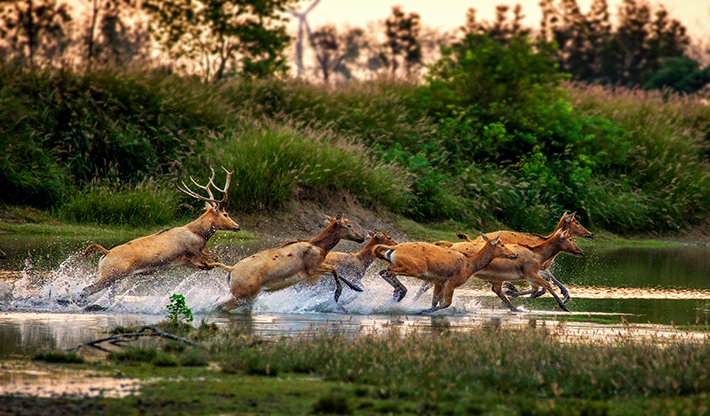Home > Wetland Species
Pere David’s Deer

Local people like to call it “Nondescript”, which derives its name for its horn looks like deer, face like horse, hoof like cow and body like donkey. According to the record in the book “Investigation on Pere David’s Deer Living Conditions”, the hometown of Pere David’s deer is in the Qin Lake area. According to the research, 72 pieces of the Pere David’s have been unearthed in Qin Lake area. Currently, there are more than 50 Pere David’s deer in the scenic area. On May every year, the heat period of male Pere David’s deer, there will be vehement fighting here. The winner will become the king that could mate with all the female.
About 2000 years ago, the Chinese feudal society has been in the golden age, and it was the best time for Pere David’s deer reproduction. At that time, the people watched, bred and ate the deer, which was much popular like today’s farmers breeding pigs and eating the pork. For various reasons, the wild Pere David’s deer population disappeared 1000 years ago, and only few hundreds were bred in the royal garden in Ming and Qing Dynasty. In 1900, after the Eight Power Allied Force invaded Beijing, the remaining few Pere David’s deer were brought overseas like prisoners of war and began their rove in the distant land for hundreds of years. Thence, on the territory of China 9.6 million square kilometers, we can’t find a Pere David’s deer anymore.
However, the humid marine climate in London was not friendly to the Pere David’s deer. In the 1980s, under the sponsorship and help of the World Wildlife Fund, the rare animal abroad returned to its China homeland from England tens of thousands miles away.
The Pere David’s deer is a kind of herbivore which usually rests in swamp to keep it away from the heat and blood sucking insects in summer. It loves the humidity environment and can endure the lower temperature and could overwinter safely under the temperature 15—18℃ minus. It enjoys living in groups, and is timid and shy, but good at running. The Pere David’s deer changes its fur twice a year. The fur is brown in summer while dust color in winter. It molts and grows new antler around coming of the New Year’s Day. It usually mates in May and July every year. The male deer will patrol around the territory during the gestation period of the female. When finding any intruder, it will make sound for alarming and even rush to fight against it. The gestation period of the female is from 270 days to 290 days with one birth for one cub. The newborn cub usually hides in the grass and begin to live with deer group after six months. When the male deer are in rut, they usually fight with each other fiercely. The winner will be the king and govern the whole female deer group.
After years’ of tracking study, the experts from Shanghai Wild Animal Research Institute, a professional team conducting the researches on Pere David’s deer, think that on the aspect of the growth habit, birth rate and so on, the Qin Lake area is more suitable for their growth and reproduction than the Dafeng area, because the land in Dafeng area is saline and alkali while the Qin Lake area has the warm and wet land that is suitable for their growth. Furthermore, according to the historical documents, the fossils discovered in Qin Lake area have been up to 72 pieces while only 4 pieces unearthed in Dafeng area, which proves from the real sense that the Qin Lake area is the last habitat before the Pere David’s deer disappeared from the earth, and also clarifies that the Qin Lake area is the hometown of Pere David’s deer.